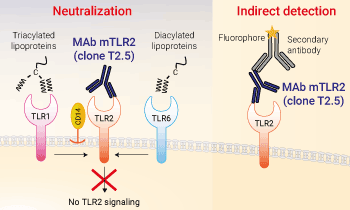Anti-murine TLR2 (clone T2.5) Detection and Neutralizing mAb
| Product | Unit size | Cat. code | Docs. | Qty. | Price | |
|---|---|---|---|---|---|---|
|
MAb-mTLR2 Anti-murine/human TLR2 mAb (clone T2.5) |
Show product |
100 µg 2 x 100 µg |
mab2-mtlr2
|
|
Detection and neutralizing antibody for murine and human TLR2 (clone T2.5) - Monoclonal Mouse IgG1

Neutralizing and detection antibody against mTLR2
MAb mTLR2 (clone T2.5) is a monoclonal antibody that reacts with murine Toll-like receptor 2 (TLR2, CD282). MAb mTLR2 is an antagonistic antibody. It has been tested by flow cytometric analysis of RAW264.7 cells. The antibody is cross-reactive with human TLR2. It was generated using recombinant DNA technology, produced in CHO (Chinese hamster ovary) cells, and purified by affinity chromatography.
TLR2 plays an essential role in detecting a diverse range of microbial pathogen-associated molecular patterns (PAMPs) [1]. An essential feature of TLR2 is its ability to form heterodimers with TLR1 and TLR6. TLR2 cooperates with TLR6 in response to diacylated mycoplasmal lipoproteins [2], and associates with TLR1 to recognize triacylated lipoproteins [3,4].
Key features:
- Reacts with murine and human TLR2
- Provided azide-free
- Each lot is functionally tested
![]() Read our review on TLR2
Read our review on TLR2
Back to the top
Specifications
Target: Murine TLR2 (mTLR2)
Specificity: Murine and human TLR2
Clonality: Monoclonal antibody
Clone: T2.5
Isotype: Mouse IgG1, kappa
Control: Mouse Control IgG1
Source: CHO cells
Formulation: 0.2 µm filtered solution in sodium phosphate buffer with glycine, saccharose, and stabilizing agents
Tested applications: Neutralization of mTLR2-induced cellular activation. This antibody can also be used for detection using flow cytometry, immunohistology on frozen tissue sections, and immunoprecipitation.
Quality control:
- This product has been validated for neutralization using cellular assays.
- The binding to mTLR2 on cells has been validated using flow cytometry.
- The absence of bacterial contamination (e.g. lipoproteins and endotoxins) has been confirmed using HEK-Blue™ TLR2 and HEK‑Blue™ TLR4 cells.
Contents
MAb-mTLR2 purified monoclonal antibody is provided azide-free and lyophilized. It is available in two quantities:
- mab2-mtlr2: 100 µg
- mab2-mtlr2-02: 2 x 100 µg
![]() Product is shipped at room temperature.
Product is shipped at room temperature.
![]() Upon receipt, store lyophilized antibody at -20°C.
Upon receipt, store lyophilized antibody at -20°C.
Back to the top
Details
Toll-Like receptors (TLRs) play a critical role in early innate immunity to invading pathogens by sensing microorganisms. These evolutionarily conserved receptors recognize highly conserved structural motifs only expressed by microbial pathogens, called pathogen-associated microbial patterns (PAMPs). Stimulation of TLRs by PAMPs initiates a signaling cascade leading to the secretion of proinflammatory cytokines following NF-κB activation. To date ten human and twelve murine TLRs have been characterized, TLR1 to TLR10 in humans, and TLR1 to TLR9, TLR11, TLR12, and TLR13 in mice, the homolog of TLR10 being a pseudogene.
TLR2 is involved in the recognition of a wide array of microbial molecules. TLR2 recognizes lipoteichoic acid and lipoprotein from Gram-positive bacteria, lipoarabinomannan from mycobacteria, and zymosan from the yeast cell wall. Moreover, TLR2 participates in the recognition of some types of LPS. TLR2 is known to heterodimerize with other TLRs, a property believed to extend the range of microbial molecules that TLR2 can recognize. TLR2 cooperates with TLR6 in response to diacylated mycoplasmal lipopeptides [1], and associates with TLR1 to recognize triacylated lipopeptides [2]. Furthermore, pathogen recognition by TLR2 is strongly enhanced by CD14 [3].
1. Girard R et al., 2003. Lipopolysaccharides from Legionella and Rhizobium stimulate mouse bone marrow granulocytes via Toll-like receptor 2. J Cell Sci. 116(Pt 2):293-302.
2. Ozinsky A. et al., 2000. The repertoire for pattern recognition of pathogens by the innate immune system is defined by cooperation between toll-like receptors. Proc Natl Acad Sci USA. 97(25):13766-71.
3. Lotz S. et al., 2004. Highly purified lipoteichoic acid activates neutrophil granulocytes and delays their spontaneous apoptosis via CD14 and TLR2. J Leukoc Biol. 75(3):467-77.




